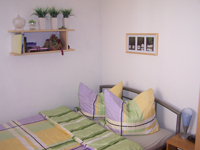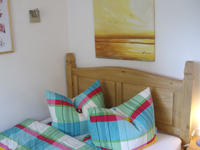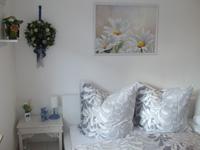Ferienwohnung-Koeln.com introduces: Buchheim
Köln-Buchheim is located on the right bank of the Rhine and belongs to the Mülheim district. The place has an area of 2,856.3 km² and approximately 13,327 inhabitants. The incorporation of Buchheim took place on April 1, 1914.

| District number | area | residents |
| 903 | 2,856.3 square kilometers | 13,500 |
Location of Buchheim
Buchheim borders the district Holweide to the east, to Höhenberg to the south, to Buchforst to the west and to the west and north at Mülheim . The Autobahn 3 forms the border with the district to the east, the B 55a to the south and the Bahntrasse to the west, which lies along Germaniastraße. The northern border is the railway line on the route to Bergisch Gladbach.
History
In 1160 there was already a first mention of a parish church in Buchheim . There are also other sources that make settlement in the Carolingian period likely. The Herl moated castle was built in 1663. The chapel of St. Johann Nepomuk was built in the 18th century with a park. Buchheim belonged to the Porz office in the Duchy of Berg. In 1795 Buchheim was also occupied by the French. The Mairie Merheim was created in 1808 and Buchheim also belonged to it. Then Buchheim belonged to the mayor's office of Merheim in the district of Mülheim.
.gif)
.gif)
.gif)
.gif)
.gif)
.gif)
.gif)
.gif)
.gif)
Old St. Mauritius in Buchheim
It is a well-preserved Romanesque cemetery chapel , which once belonged to the parish church from Buchheim at the time. The so-called "Old St. Mauritius". This parish church was first mentioned in 1160.
At that time, the parish church still belonged to Deutz Abbey and the rest, which is still well preserved, is dated back to 1200! So it's a really old holdover!
.gif)
.gif)
.gif)
.gif)
.gif)
.gif)
.gif)
.gif)
.gif)
War damage
During the time of the Truchsessian War, the sacral house was badly damaged in 1583. The damage was then repaired between 1586 and 1593 and the opportunity was taken to add two so-called "transept arms". But even in 1795 the war did not mean well with this church and it was almost completely destroyed. Afterwards the parish rights passed to the church of St. Clement in Mülheim. The ruins of the church were only renovated in 1849 and converted or expanded into a cemetery chapel. But even after that, this church or chapel did not come to rest, because even in the years 1943 to 1944 it had suffered war damage. The cemetery chapel was then rebuilt only in the years 1950 to 1952.
Remains of the Romanesque church
The semicircular apse, which presents seven flat round arch elements in its simple style, counts as a significant remnant of the Romanesque parish church.
.gif)
.gif)
.gif)
Outer fortress belt
The intermediate plant Xc, which is located in the south of the Schlagbaumweg, was built between 1877 and 1879. It lies west of the highway and in 1922 it was partially razed. Fort XI is located in Buchheim and was used by the 7th Company of Infantry Regiment 16.
From Fort XI are still preserved: Throat barracks, log house, trench wall, flank trenches without a wall and sections of the ramparts. The former fortress floor plan in green design and path is recognizable.
The intermediate plant XIa in Buchheim: Herler Ring is located west of the motorway. In 1923 there was a redesign plan by Fritz Encke for a green fort with a sports facility. An auxiliary police force was located here during the Second World War. There are traces of the side ditches with adjacent ramparts.
Religious buildings
The St. Mauritius Catholic Church was built in 1896. It was built in the neo-Gothic style. The church is the successor of the Alt St. Mauritius chapel. There is also the Evangelical Kreuzkirche from 1961/62.
- St. Theresia of the child of Jesus: it is a Catholic church built in the round style
- Herler Chapel St. Johann Nepomuk
- Mosque of the VIKZ, in the Villa Hahnenburg
Mills on the beach
There are many mills at the hour that use hydropower. There is the Herler Mühle in the Buchheim district. This still has a water wheel and the Buchheimer mill, which was demolished in 1910.
Miscellaneous from Buchheim
The cable manufacturer Felten & Guilleaume built company apartments in Buchheim . From 1991 it became known on TV by the family Fussbroich . There was a first documentary soap that took its main location here.
Sights of Buchheim
Here are to be mentioned:
- Herl Castle
- The chapel of St. Johann Neopmuk
- The church of St. Mauritius with the steeple "Herjottszejefinger"
- The Kreuzkirche
- The Buchheimer Kreuz
- The Herler Mill
- The intermediate plant Xc
- Fort XI in Piccoloministrasse with club house
- The intermediate plant XIa at Herler Ring 33 with club house
The Herler Mill
It was one of the numerous watermills in Cologne (or the surrounding area as well as Bergisch Gladbach). The Herler mill on the tributary of the Rhine, the Strunde.
History of the mill
The first indications of a mill in today's Buchheim can be found in a document by Konrad II, who gave away three mansions (medieval area) with everything "on it". The recipient of this noble donation was the Deutz Abbey. The three manses were probably about 33-48 hectares in area. The following were also given away on this area:
- Paths and Paths
- Exits
- Fisheries
- mills
- Forests
- Weiden
- Fields
- surfaces
- even serfs (!)
- Building
- and much more
And there were just mentioned the mills.
In 1584 Mr. Otto Schenk von Nideggen suddenly appeared as the owner. In 1744 the owner of the mill changed, because a certain Mr. Anton Michael Heister bought the mill and then leased it to some millers who were able to work there. In 1786, a Mr. Johann Wilhelm Kießel was listed as the tenant of the mill. Johann Wilhelm Kießel is a grinder by profession and therefore it can be assumed that the mill was used as a grinder .
It came in 1814 and a Mr. Jakob Ringen the Elder then bought the mill to use it as an oil mill. The mill was rebuilt and equipped with a four-inch larger water wheel. From then on, the mill was now used as a grain mill. The Ringen family now remained in the mill for a long time (about 150 years) and even exchanged the wooden wheel for an iron wheel . This happened in 1895. Ultimately, in 1960 a certain Mr. Nikolaus Rosiny (architect by profession) acquired the mill and then restored it quite extensively. Now there are business premises and apartments in the old mill.
In 1984 (exactly on June 13th) the old watermill was even registered as a monument under paragraph 2 paragraphs 1 and 2 of the Monument Protection Act.
Book accommodation
Do you want to spend a few days in the cathedral city? We have the perfect accommodations for you! Ask right away at Apartments cologne for a non-binding offer! apartments near Koelnmesse and the vacation rentals are very close to the fair! We look forward to your non-binding inquiry!






